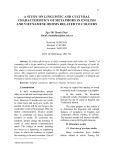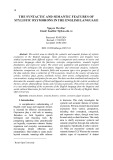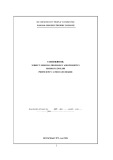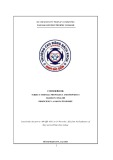
66
HNUE JOURNAL OF SCIENCE
Educational Sciences 2024, Volume 69, Issue 4, pp. 66-77
This paper is available online at https://hnuejs.edu.vn
DOI: 10.18173/2354-1075.2024-0164
EMBEDDED ADJECTIVES IN CHINESE AND VIETNAMESE QUANTITATIVE
NOUN STRUCTURES FROM A COGNITIVE PERSPECTIVE
Hy Thi Hong Nhung
Faculty of Chinese Language and Culture, Hanoi National University of Education,
Hanoi city, Vietnam
Corresponding author: Hy Thi Hong Nhung, e-mail: nhunghth@hnue.edu.vn
Received August 13, 2024. Revised September 30, 2024. Accepted September 30, 2024.
Abstract. From a cognitive perspective, this paper provides an in-depth analysis of the
embedded adjectives in the structure of Chinese and Vietnamese quantitative nouns. It
employs the theory of distance iconicity and image schema to reveal the cognitive strategies
of these languages. The conceptual components within the structure of numeral classifiers
are close, and thus they should also be close in language form. Conversely, the conceptual
components in the structure of collective classifiers and container classifiers are distant from
each other, and therefore, they can be separated in language form. Additionally, when the
image is perceived as a whole, the cognitive strategy of summary scanning is adopted. When
the image can be decomposed into processes, the cognitive approach of sequential scanning
is adopted. There are many syntactic differences between Chinese and Vietnamese in such
structures, but certain cognitive rules can still be identified. In the future, we will strive to
provide more comprehensive summaries and natural explanations of the language structures
of Chinese and Vietnamese, particularly the syntactic structures.
Keywords: image schema, distance-iconicity, Chinese, Vietnamese, embedded adjectives.
1. Introduction
Overview of the studied structure
Cognitive linguistics is an interdisciplinary branch that studies the relationship between
general principles and cognitive laws of language. The study of cognitive linguistics has
penetrated every aspect of language and every branch of linguistics.
Cognitive linguistics assumes that human language ability is not an independent ability but
is closely related to general cognitive ability. As a part of language structure, syntax is non-
autonomous and inseparable from the lexical and semantic parts of the language (Croft, William,
2004). Cognitive linguistics argues that semantics is not just truth-conditional or objective but a
combination of subjective and objective elements. The study of semantics always involves
people's subjective views or psychological factors. It can be seen that there is a significant
difference between cognitive linguistics and formal linguistics.
Chinese and Vietnamese are analytic languages, and both have the grammatical phenomenon
of embedded adjectives in the middle of quantitative noun structures. This similarity contrasts
with significant differences in their syntax. Let’s first examine this structure syntactically.
In Chinese, adjectives are embedded within quantitative noun structures in two positions.
The analysis of the structural level is as follows:

Embedded adjectives in Chinese and Vietnamese quantitative noun structures from a cognitive perspective
67
The first position is “Number + Classifier + Adjective + Noun”.
1
2
1 - 2 modifier-head structure
3 4
5 6
3 - 4 quantity structure
5 - 6 modifier-head structure
For example:
(1)
a.
yi ben hou shu
b.
yi dui da mutou
a thick book
a pile big logs
‘a thick book’
‘a pile of big logs’
Most scholars assume that “Number + Adjective + Classifier + Noun” is the structure of
an adjective modifying a classifier
1
2
1 - 2 modifier-head structure
For example:
(2)
a.
yi hou ben shu
b.
yi da dui mutou
a thick book
a big pile logs
‘a thick book’
‘a big pile of logs’
Vietnamese adjectives are embedded into quantitative noun structures. The analysis at the
structural level is as follows:
The structure of “Number + Classifier + Noun + Adjective” in Vietnamese is relatively
complicated, with two different semantic relationships:
The first semantic relationship indicates the type of object being weighed. Syntactically,
there is a direct compositional relationship between numerals and measure words, as well as
between nouns and adjectives. Vietnamese is a typical SVO (Subject-Verb-Object) language.
According to a feature in linguistic typology, all languages that use a VO (Verb-Object) word
order follow the organizational pattern of “head + modifier” or “head + adjunct.” Consequently,
in Vietnamese, the NA word order, that is [Noun + Adjective], is the basic word order.
1
2
1 - 2 modifier-head structure
3 4
5 6
3 - 4 quantity structure
5 - 6 modifier-head structure
For example:
(3)
a.
một đống đá to
a pile stone big
‘a pile of big stones’
According to hierarchical analysis, “một đống đá to” can be understood as “a pile of big
stones.”
N
C
A
Ns
N
C
Ns
A
N
A
C
Ns

Hy THN
68
The second semantic relationship describes the quantity of the object. In this case, the
structure of “Number + Classifier + Noun + Adjective” can generally be understood as an
adjective modifying the quantitative noun structures, so the embedded adjective is not limited.
The analysis at the structural level is as follows:
1
2
1 - 2 subject-predicate structure
3
4
3 - 4 modifier-head structure
5 6
5 - 6 quantity structure
“Number + Classifier + Noun” and “Adjective” are the direct components of the first level.
The meaning of (3a) is “a big pile of stones”.
The structure of “Number + Classifier + Adjective + Noun”
1
2
1 - 2 modifier-head structure
For example:
(4)
một lớp dày kem dưỡng ẩm
a layer thick moisturizer
‘a thick layer of moisturizer’
In conclusion, the Vietnamese “Number + Classifier + Noun + Adjective” structure is
potentially ambiguous, as it may have two syntactic structural relationships and correspondingly
express two different semantic relationships. However, it can also be univocal.
(5)
một chồng bát cao
a stack bowl high
‘a high stack of bowls’
Because “bát” (bowl) and “cao” (high) have no modification in (5), Vietnamese people do
not say “bát cao” (bowl high), so “một chồng bát cao” can only be understood in one way: the
adjective modifies the “Number + Classifier + Noun” structure.
In addition, the Vietnamese “Number + Classifier + Noun + Adjective” structure is similar
to the Chinese “Number + Classifier + Adjective + Noun” structure, which has a wide range of
applications, and there are basically no restrictions on the embedded adjectives, making it
inconvenient for regularization and summary.
On the other hand, from the perspective of syntactic and semantic functions, the Chinese
“Number + Adjective + Classifier + Noun” (yi hou ben shu) and the Vietnamese “Number +
Classifier + Adjective + Noun” (một hàng dài fan hâm mộ) are univocal syntactic structures and
have more comparable points. Therefore, this paper focuses on these two structures. Through the
theory of cognitive linguistics, we provide an explanation for this structure in Chinese and
Vietnamese.
Teaching embedded adjectives cannot rely solely on simple memory. Syntactic analysis,
semantic participation, and specific context must also be considered, and even cognitive
N
C
Ns
A
N
C
A
Ns

Embedded adjectives in Chinese and Vietnamese quantitative noun structures from a cognitive perspective
69
explanations are required. We hope that our research results can provide valuable references for
teaching Chinese as a foreign language and, at the same time, serve as useful reference material
for Vietnamese learners.
Previous research status
Regarding the use of embedded adjectives in quantitative noun structures, there are not many
studies in the field of Chinese grammar. At present, we only see a few articles and grammar books,
as shown below.
Zhu Dexi (1982) divided the situations in which classifiers are modified by adjectives into
two types: one is temporary classifiers, which can be modified by adjectives or nouns because
they are originally nouns. The second is numeral classifiers. A few numeral classifiers can be
modified by monosyllabic adjectives, but the adjectives are limited to a few, such as “da” (big),
“xiao” (small), “chang” (long), and “fang” (square).
From the perspective of whether the things represented by nouns can be divided, Liu Yuehua
(1983) showed that if the things represented by nouns after numeral classifiers can be divided, the
two adjectives “da” (big) and “xiao” (small) can be inserted between numbers and classifiers. For
example, “yi da kuai dangao” (a big piece of cake) and “yi xiao tiao bu” (a small piece of cloth).
These adjectives can also be used before most collective classifiers expressing indefinite numbers.
However, before a certain number of collective classifiers, it is not allowed. Adjectives describing
the shape of objects such as “hou” (thick), “bao” (thin), and “chang” (long) can sometimes be
used before some nouns and inserted among quantitative phrases. Since container classifiers are
originally nouns, an adjective can generally be added in front of them.
Lu Jianming (1987) examines in detail the situation of embedded adjectives in the middle of
Chinese quantitative structures. Firstly, from the perspective of classifiers, he inspected 630
commonly used classifiers and found that only 129 classifiers can be inserted into the middle of
quantitative structures, accounting for 20% of the total number of classifiers. However, adjectives
cannot be inserted in the middle of quantitative structures composed of measurement classifiers.
Secondly, from the perspective of numerals, the number structure with the number “yi” (one) has
the highest interpolation, with 289 out of 328 examples, accounting for 88.1%. Thirdly, the
investigation of adjectives showed that not all adjectives can be inserted in the middle of the
structure; only seven such as “da” (big), “xiao” (small), “man” (full), “chang” (long), “zheng”
(whole), “hou” (thick), and “bao” (thin) can be inserted. Lu Jianming only described these
phenomena objectively without further explanation. Luo Yuanlin (1998) made a supplementary
investigation to Lu Jianming's article and provided a preliminary analysis and explanation of this
structure from the perspective of semantic and contextual constraints.
Most Vietnamese grammar books involve numerals and classifiers, but they mainly study
the classification, semantic features, and grammatical functions of classifiers. At present, there is
no research on embedded adjectives in the quantitative noun structures of Vietnamese. The
comparative study of embedded adjectives in the quantitative noun structures in modern Chinese
and Vietnamese has not yet been discussed by experts and scholars.
Among the relevant materials we have collected, there are only two theses that compare the
classifiers or quantitative phrases of the two languages, such as those by Ruan Shiyuhe (2007)
and Ruan Chunmian (2006), but none of them involve the comparison of embedded adjectives.
It can be seen that the comparative study of embedded adjectives in the quantitative noun
structures of modern Chinese and Vietnamese is still quite weak, almost nonexistent. However, it
is very important for an in-depth understanding of Chinese and Vietnamese classifiers,
quantitative noun structures, word order, and other issues. It is also of paramount importance to
the study of cognitive linguistics. Therefore, we decided to use the theory of cognitive linguistics
to conduct an in-depth elaboration on embedded adjectives in the quantitative noun structures of
modern Chinese and Vietnamese.

Hy THN
70
2. Content
2.1. Research Methods
2.1.1. Image schema
In the human cognitive system, in addition to the basic categories, the cognition of the
relationships among things constitutes another important cognitive level, which Lakoff (1987)
called the “kinesthetic image schema” (or “image schema”). Image schema is the organizational
structure that connects abstract relationships and concrete images in human experience and
understanding. It is a fundamental structure for understanding and recognizing more complex
concepts. Human experience and knowledge are based on these basic structures and relationships.
There are many image schemas in human experience, which Lakoff (1987) summarized as:
1. The PART-WHOLE schema: People and other objects are wholes composed of parts. Only
parts that exist in the same structure form a whole. Human experience considers families and
other social groups as wholes made up of parts, and divorce is seen as “disintegration.”
2. The LINK schema: Social and interpersonal relationships are viewed as connections.
3. The CENTER-PERIPHERY schema: The human body has a center and edges; similarly,
trees and plants have trunks, branches, and leaves. The center is important, the edge is
unimportant, and the edge depends on the center for its existence.
4. The SOURCE-PATH-GOAL schema: When an object moves from one location to
another, there must be a starting point, an ending point, and a path. The purpose is seen as
the end, and reaching the goal is “reaching the end.”
Other schemas include the UP-DOWN schema, FRONT-BACK schema, LINEAR ORDER
schema, and so on.
In the structures we investigated, different classifiers are cognitively examined in different
ways. This cognitive strategy can be revealed according to the image schema of cognitive
linguistics.
2.1.2. Distance iconicity
Haiman (1983) expressed distance iconicity as the concept that the distance between
concepts is often similar to the distance among linguistic symbols. Givón (1985) called this the
proximity principle, defined as “entities that are closer together functionally, conceptually, or
cognitively will be placed closer together at the code level.” In other words, distance iconicity
means that the closer the surface form connection among elements is, the closer the meaning
connection is, and the formal relationship is an imitation of the meaning relationship.
This feature of language is not a new discovery of contemporary functional linguists; it was
recognized by traditional linguists through their nuanced insight into individual languages. For
example, Behaghel (1932) proposed a rule when discussing German word order, which was called
the “principle of concept proximity” or “Behaghel's first law” by later generations. Jespersen
(1949) also proposed a “principle of adhesion” with similar content. However, contemporary
linguists have rediscovered this principle while trying to explain language universals, bringing
new meaning to this universal phenomenon in human language.
In the structures we investigated, there is a phenomenon where other elements can be
embedded in both Chinese and Vietnamese. Distance iconicity will help us determine under what
circumstances embedding occurs and why it can or cannot be embedded.
2.2. Our proposal
2.2.1. Classification
In this structure, the classifiers can be object classifiers, verb classifiers, tense classifiers, etc.
This paper only discusses the case of object classifiers. Three kinds of object classifiers can be






![[Chuẩn nhất] Ngữ Pháp Cơ Bản: Sự Phối Hợp Thì (Sequence of Tenses) trong Tiếng Anh](https://cdn.tailieu.vn/images/document/thumbnail/2025/20250311/tinhtamdacy000/135x160/1246685478.jpg)





![Tài liệu Ngữ pháp HSK 3 [chuẩn nhất/ đầy đủ/ chi tiết]](https://cdn.tailieu.vn/images/document/thumbnail/2025/20251108/yenlethingoc49@gmail.com/135x160/11711762589284.jpg)


![Bài giảng Tiếng Trung Quốc du lịch khách sạn [Tập hợp]](https://cdn.tailieu.vn/images/document/thumbnail/2025/20251003/kimphuong1001/135x160/7291759464952.jpg)
![Đề thi Tiếng Trung 1 học kì 2 năm 2024-2025 có đáp án (Đề 2) - [Tuyển tập đề thi]](https://cdn.tailieu.vn/images/document/thumbnail/2025/20250920/kimphuong1001/135x160/76371758358928.jpg)

![Tài liệu Ngữ pháp HSK 2 [mới nhất]](https://cdn.tailieu.vn/images/document/thumbnail/2025/20250916/thanhhoa.lda@gmail.com/135x160/3241757994918.jpg)

![Đề thi Tiếng Trung 1 học kì 2 năm 2024-2025 có đáp án (Đề 1) - [Tuyển tập]](https://cdn.tailieu.vn/images/document/thumbnail/2025/20250823/kimphuong1001/135x160/95221755919445.jpg)





